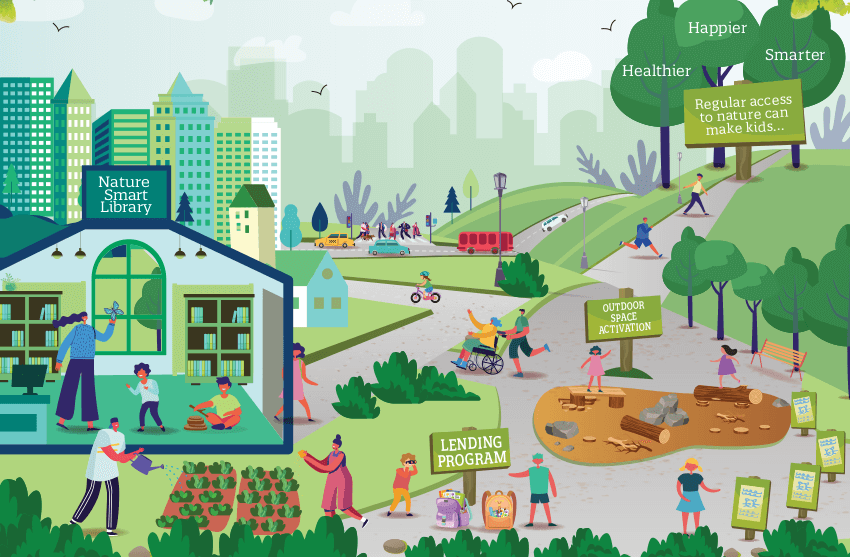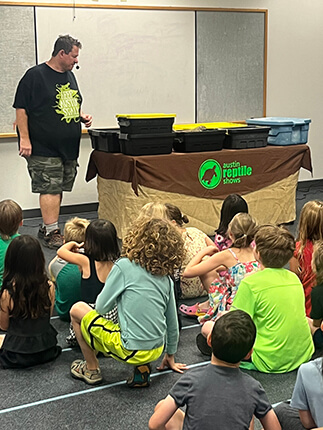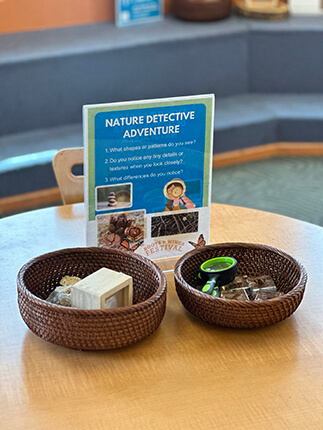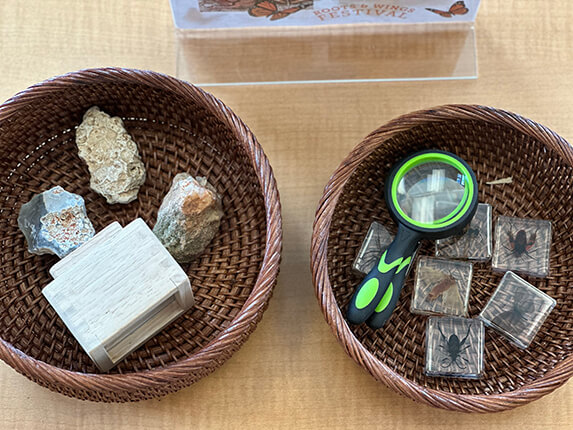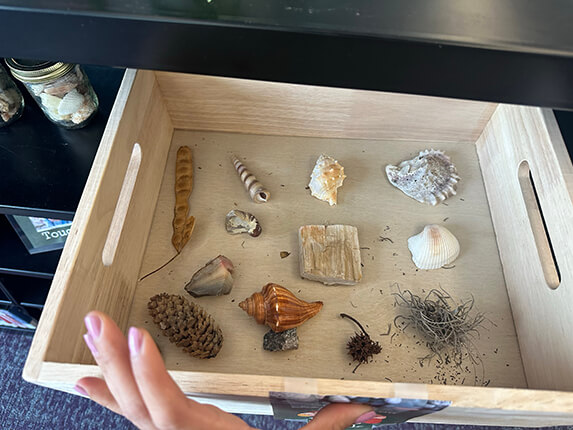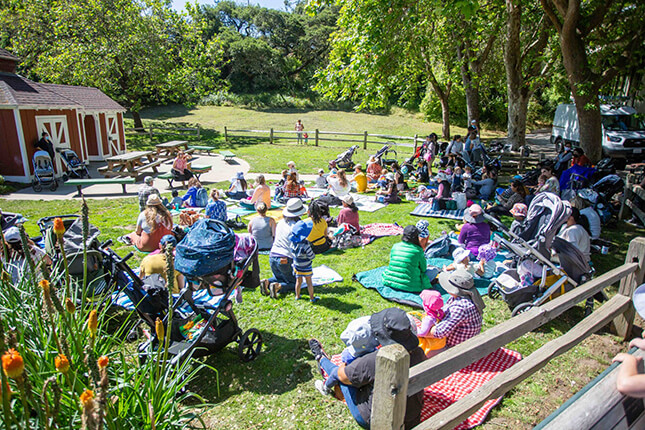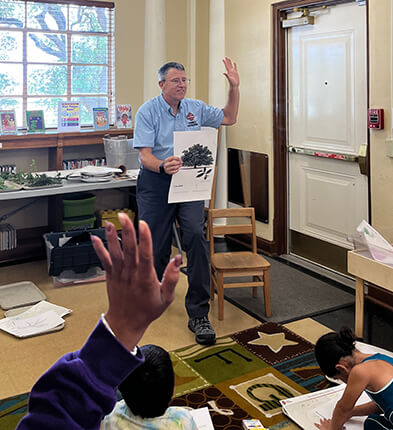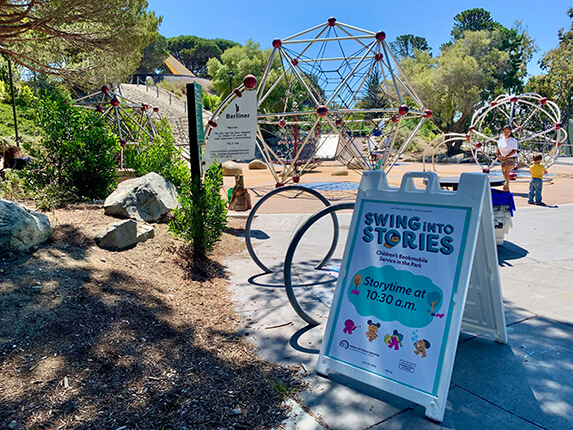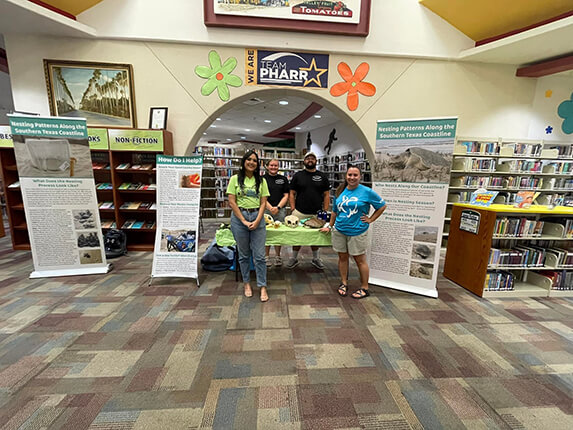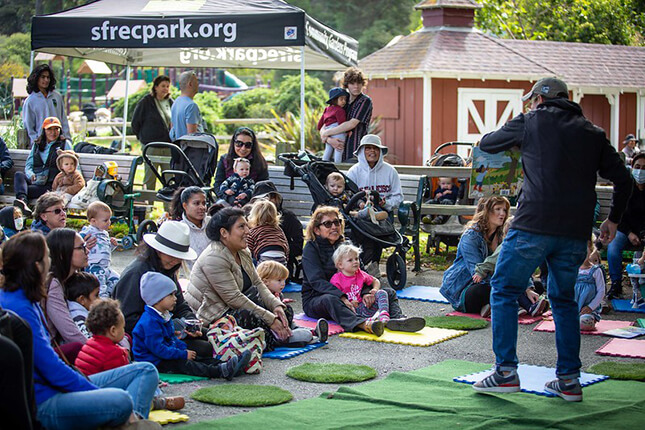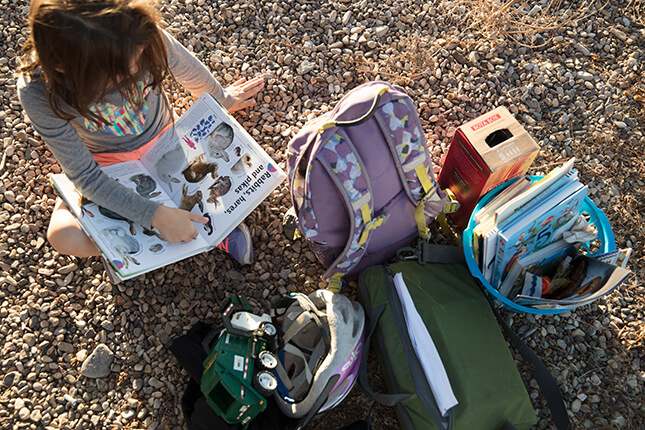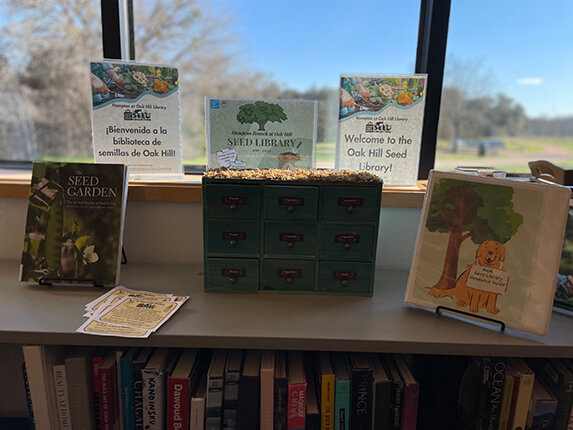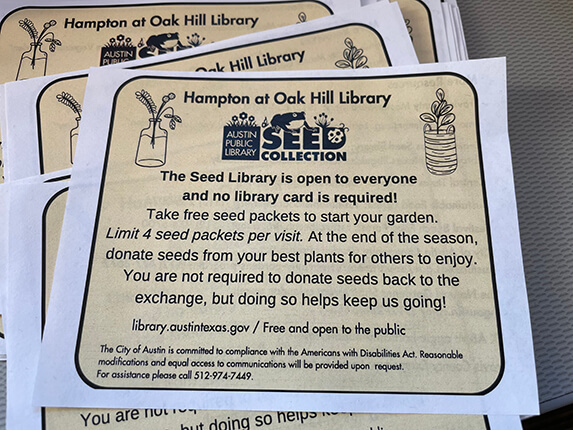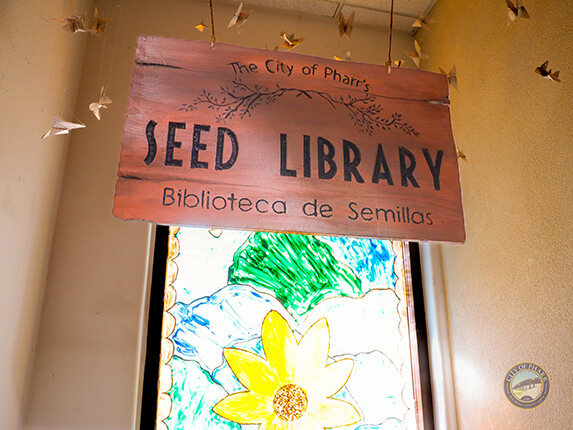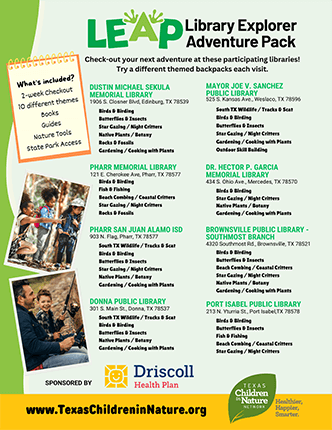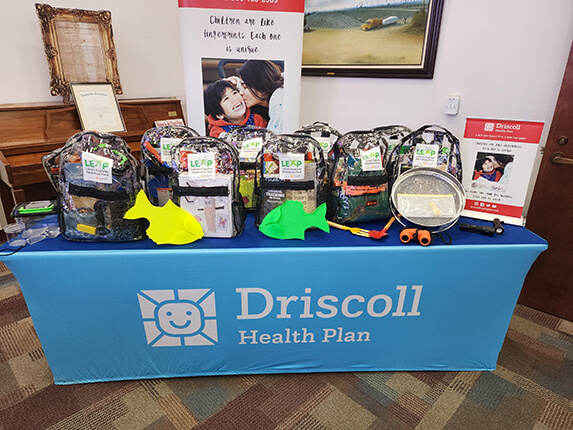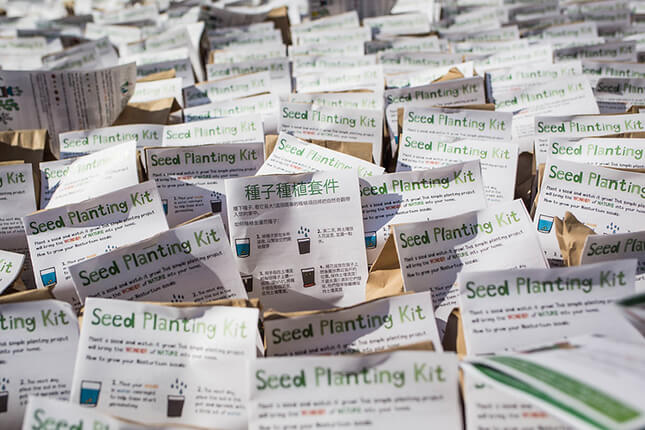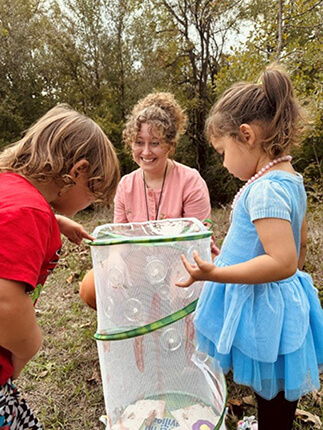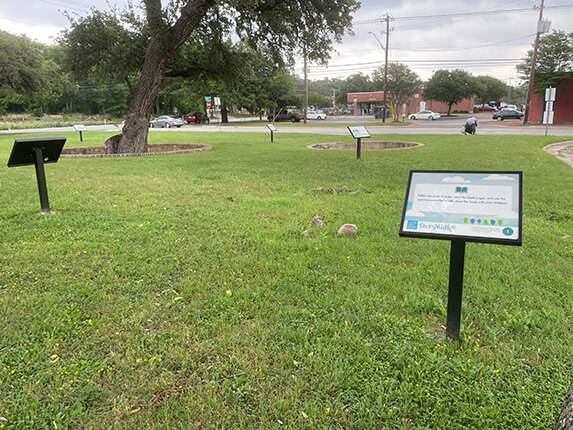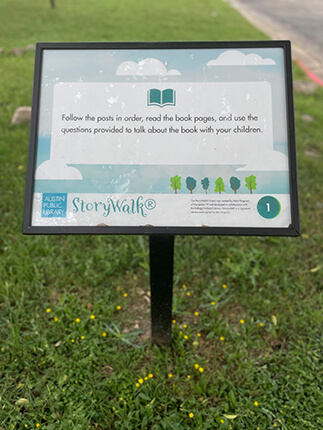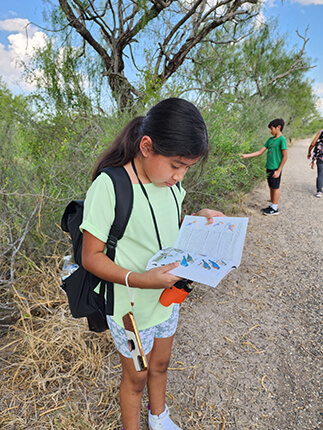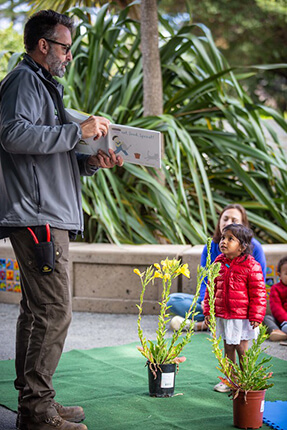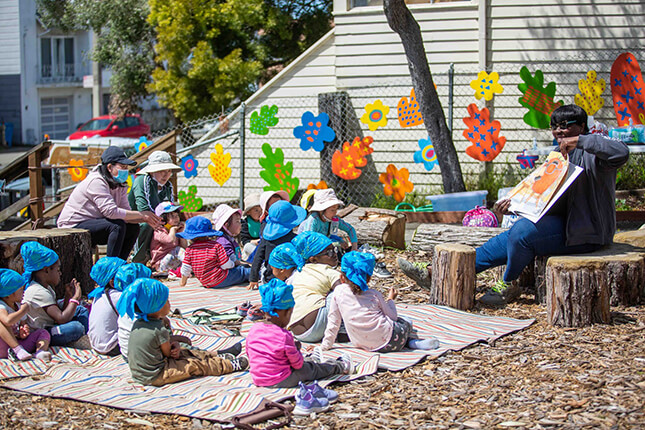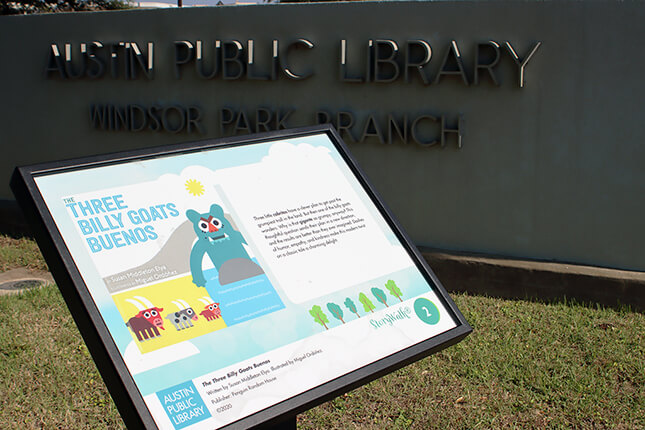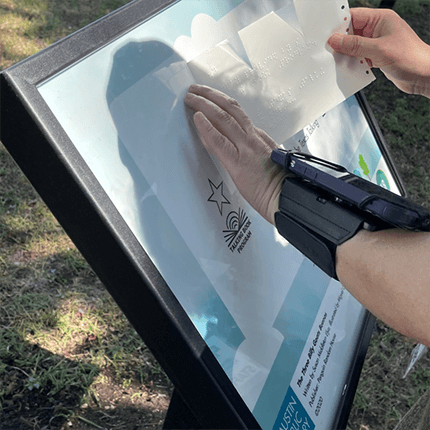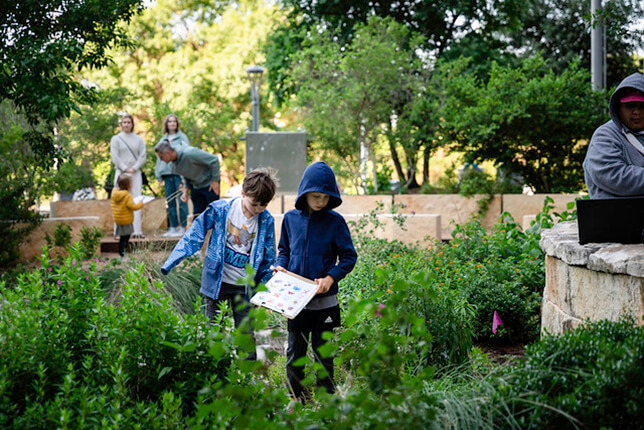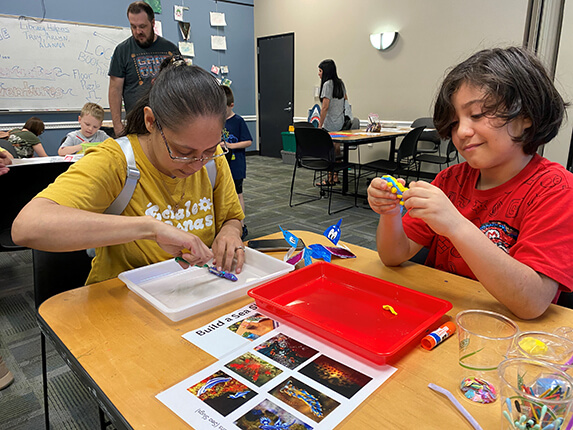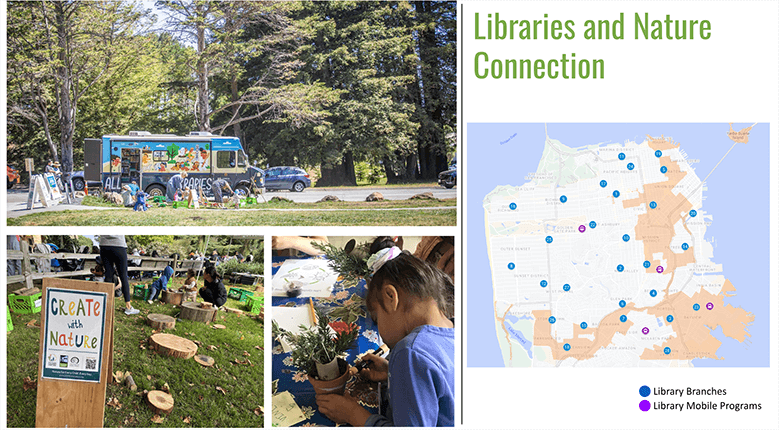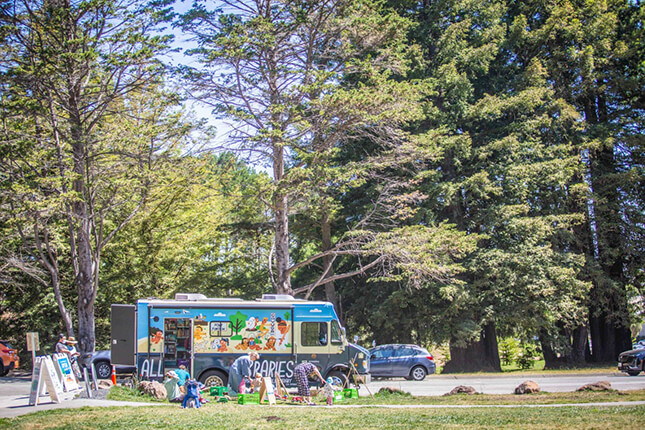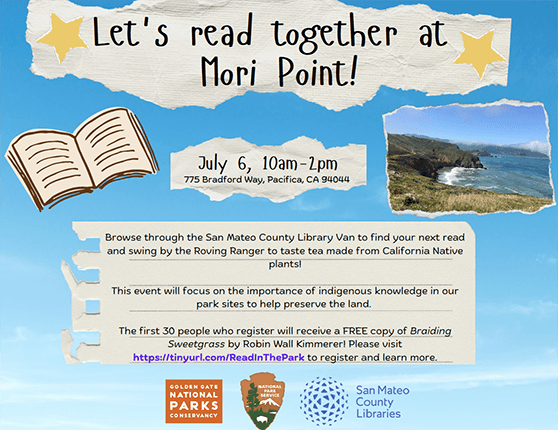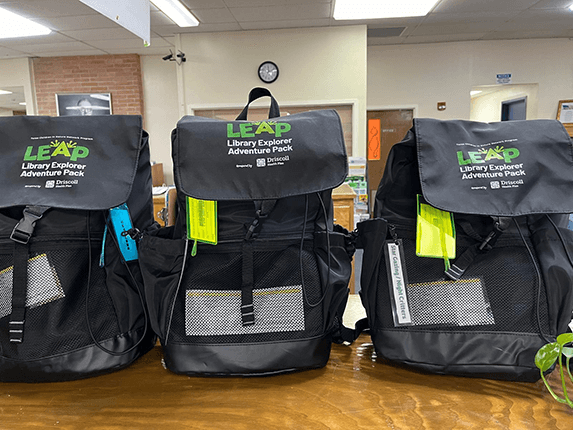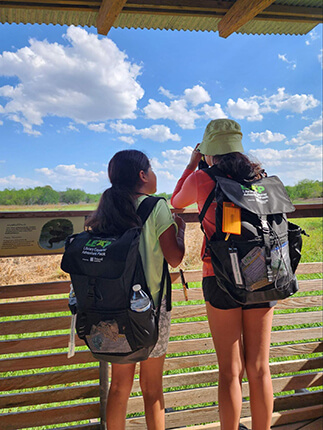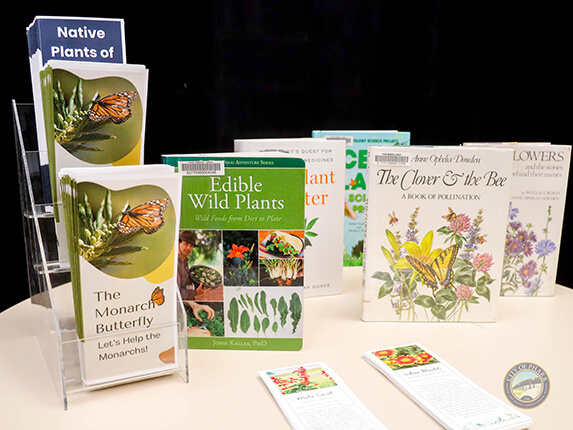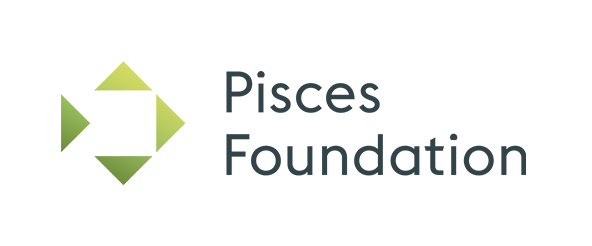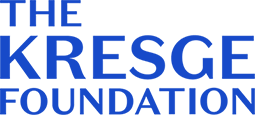Nature-Smart Libraries: A Toolkit
As community hubs, libraries can provide children with regular access to nature programs, nature-based collections and outdoor spaces.
“Libraries exist in every kind of neighborhood; they already serve as community hubs; they’re often supported by Friends groups; they have existing resources (nature books); they’re often more flexible than schools; they’re known for being safe—and they’re a perfect, if unexpected, institution to connect people to nature.”
– Richard Louv, The New Nature Movement
Nature benefits kids—making them healthier, happier, smarter, and better stewards of the environment. Communities across the U.S. are expanding nature spaces and programs where children live, learn, and play, and libraries are ideal partners in this effort. With most people living within two miles of a local library, libraries are community hubs that can foster nature connections through lending programs, curated collections, and outdoor spaces.
This toolkit highlights innovative, Nature-Smart Library initiatives nationwide, showcasing how libraries can collaborate with cities, parks, and community partners to expand nature access. While many libraries lead individual efforts, this toolkit emphasizes system-wide strategies to ensure nature is accessible across entire communities.
Nature-Smart Libraries intentionally integrate nature into their services, programs, and physical environments to promote equitable access to the outdoors. Nature-Smart Libraries can:
- Align with local goals, enhancing community well-being, early literacy, and climate resiliency.
- Serve children and caregivers who may lack access to quality nature experiences.
- Create and sustain nature connections by offering hands-on nature programs, expanding relevant collections, providing outdoor play and learning spaces, and supporting staff training to bring nature’s benefits to library patrons effectively.
- Foster partnerships with local organizations to strengthen community engagement and ensure that nature opportunities are accessible to all.
What makes a library nature-smart? A Nature-Smart Library connects communities to nature through programs, curated collections, lending, and nature-rich spaces. It invests in staff training and typically starts at one branch before expanding across the community. While many initiatives begin locally, the goal is to build partnerships and establish systems that expand these efforts city- or region-wide.
Libraries can foster nature connections through programs led by library or partner staff that engage children with nature through experiences, environments, or themed activities. Examples include:
- Adding nature, sustainability, and environmental themes to existing programs like storytime or after-school activities.
- Offering programs in nature-themed spaces such as outdoor gardens, classrooms, or plant-filled indoor areas.
- Introducing multigenerational programs, like family nature or gardening clubs, that promote regular family engagement with nature.
- Partnering with parks or environmental organizations to host off-site programs and providing transportation to parks or conservation areas.
Libraries can extend nature exploration beyond books by offering nature-based collections and creative lending programs that provide free or low-cost resources for self-directed exploration. Collections can be built over time, responding to community interests and needs. Options include:
- Developing a nature-based collection featuring books that promote environmental awareness and include top nature books for children.
- Lending gear for recreational activities like camping, fishing, and gardening to reduce equipment access barriers.
- Offering passes for free entry to state parks, national parks, and local attractions such as botanic gardens, zoos, and museums.
- Providing Nature Backpacks with supplies like wildlife guides, magnifying glasses, and related books to encourage nearby nature exploration.
- Establishing Seed Libraries where community members can exchange seeds and engage children in gardening activities.
- Extending lending opportunities through Library in Parks installations that bring resources to nearby parks and neighborhoods.
Libraries can leverage nearby outdoor spaces such as gardens, parks or green space for programs or activities. They can also partner with park departments to utilize adjacent or nearby parks for library programs or create nature-filled indoor spaces to enhance programming. Examples include:
- Creating outdoor spaces for storytime, nature play, or quiet reading to foster nature connections.
- Installing nature paths that connect the library with other community assets like parks and schools.
- Adding StoryWalks® along paths by displaying laminated book pages for outdoor reading experiences.
- Incorporating biophilic design indoors to bring nature inside and provide year-round opportunities for nature connection.
- Highlighting facility sustainability features, such as solar panels and rainwater collection, to teach environmental stewardship.
- Developing gardens at or near libraries and partnering with community organizations to establish edible, pollinator, or native gardens.
- Adding wildlife features, such as bee hives, birdhouses, bird feeders, or bat houses near libraries.
Libraries serve as accessible community hubs, providing welcoming spaces for families to explore new topics and experiences. With strong local reputations, dedicated staff, expertise in youth engagement, and outdoor spaces, libraries can support community efforts to expand access to nature. Effective collaboration ensures practical, programmatic solutions that maximize resources and drive meaningful progress towards Nature-Smart Library goals. Nature-Smart Libraries thrive through collaboration with local governments and community organizations, aligning efforts to support children, families, and environmental awareness.
This section on Partnership Building stems from over 10 years of working with communities across the country to implement strategies for children and nature. They have proven to be critical steps in any process. We’ve adapted them here to support efforts to build Nature-Smart Library programs specifically.
Understanding how Nature-Smart Libraries align with local priorities and how they can help achieve city or county goals helps library staff and potential partners understand how best to approach the collaboration. Common goals include: community well-being, health and happiness, early childhood literacy, and sustainability and climate resiliency. Nature-Smart Libraries can support all of these goals.
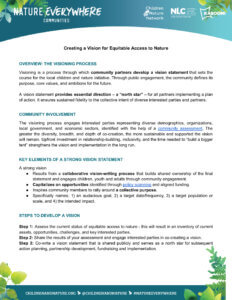 Creating a Vision
Creating a Vision
This resource aims to support a visioning is a process through which community partners develop a vision statement that sets the course for the local children and nature initiative. Through public engagement, the community defines its purpose, core values, and ambitions for the future.
Read MoreNature-Smart Library programs thrive through partnerships with parks departments, sustainability offices, and community organizations. These collaborations can flourish into official partnership agreements, shared vision statements, strategic plans, and formalized resource-sharing plans backed by institutional leaders. Within the library system, administrators, youth services librarians, and community engagement librarians typically lead these efforts. Identifying stakeholders who share a commitment to connecting children and families with nature strengthens alignment and fosters lasting partnerships. Ideally, libraries and their partners meet regularly, at least quarterly, to maintain momentum and support ongoing collaboration.
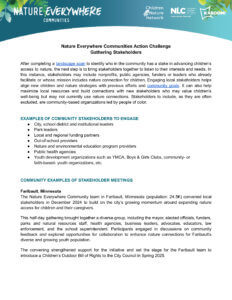 Engaging Stakeholders
Engaging Stakeholders
Engaging local stakeholders helps align new children and nature strategies with previous efforts and community goals. It can also help maximize local resources and build connections with new stakeholders who may value children’s well-being but may not currently use nature connections. This resource supports communities in bringing local stakeholders together to support local efforts.
Read More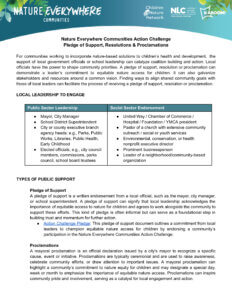 Pledges of Support
Pledges of Support
For communities working to incorporate nature-based solutions to children’s health and development, the support of local government officials or school leadership can catalyze coalition building and action. A pledge of support, resolution or proclamation can demonstrate a leader’s commitment to equitable nature access for children. This resource provides an overview of types of support and examples.
Read More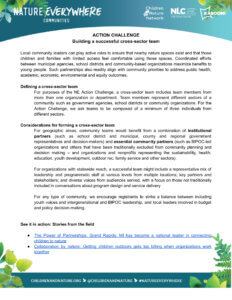 Cross-sector teams
Cross-sector teams
What is a cross-sector team and why is it important for the success of Nature Everywhere Communities initiative? This one-page resource defines a cross-sector team and looks at considerations for how to form a successful team. This resource is targeted to support Action Challenge communities.
Read MoreCommunity assessments identify assets, opportunities, and investment priorities, helping prioritize branch locations to serve children and caregivers lacking quality nature experiences. Nature-access and equity mapping highlight branches with the highest concentration of children to better understand reach. A landscape scan reveals shared goals, available resources, and collaboration opportunities to maximize impact. While the linked Equity Mapping Toolkit focuses on early childhood, its steps apply broadly to Nature-Smart Libraries and all children.
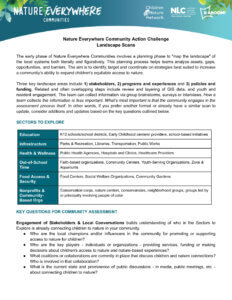 Landscape Scan
Landscape Scan
The early phase of Nature Everywhere Communities involves a planning phase to “map the landscape” of the local systems both literally and figuratively. This planning process helps teams analyze assets, gaps, opportunities, and barriers. This resources provides a high-level view of what to consider when doing landscape scans for stakeholders, programs and experiences, and policies and funding in a community.
Read More Equity Mapping
Equity Mapping
Equity maps depict how nature appears in a city relative to key demographic, economic, and social data. Cities use equity maps to prioritize programming, funding and resources to areas most in need. This resource guide provides step-by-step process for creating equity maps.
Read MoreNature-Smart Libraries leverage a library’s proximity in a community as a way to embed nature into daily life. As community hubs, libraries have the unique ability to provide lasting nature connections beyond one-time programs, expanding their impact through a variety of nature-based experiences and with the potential to extend across entire communities. Partners might ask: How can this be sustained over time and scaled effectively? How can libraries integrate nature-based initiatives into their systems to ensure longevity, regardless of staffing changes?
The approach will vary across library systems and cities, depending on resources, community involvement, and location—whether urban, rural, or adjacent to natural spaces. The goal is to move beyond isolated programs and make nature engagement an intentional, integrated part of library operations, budgets, administration, and partnerships.
Scaling efforts may involve expanding nature programs to all branches, increasing the variety and frequency of nature-based opportunities, or establishing formal partnerships at the city, regional, or state level to ensure long-term support. Since libraries reflect the unique needs of their communities, approaches will vary based on local demographics, priorities, and resources. Ultimately, a Nature-Smart Library strategy aims to provide consistent and diverse nature connections across multiple locations and touchpoints.
Libraries can expand access to nature through programs, curated collections, lending, and nature-rich spaces while also advancing environmental awareness and family engagement. To effectively change how communities approach children’s access to nature, we recommend a systems change approach. This approach addresses barriers such as policies, funding, and power dynamics while shifting mindsets to recognize libraries as key players in connecting children with nature. For Nature-Smart Libraries, that often means changing the way residents and community leaders view the role of libraries in helping to bring nature’s benefits to local children.
 Equitable Access to Nature: A Systems Change Approach (video)
Equitable Access to Nature: A Systems Change Approach (video)
The Cities Connecting Children to Nature (CCCN) initiative supports cities as they work to change and improve citywide systems so that all children have opportunities to play, learn and grow with nature in their daily lives. Many cities are searching for ways to bring nature’s benefits to all.
Watch Video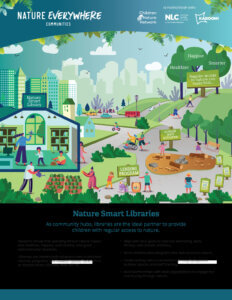
Nature-Smart Library Infographic
As community hubs, libraries are the ideal partners to provide children with regular access to nature. This infographic provides a helpful visual of how libraries can help connect children to nature. Use this to help build understanding of Nature-Smart Libraries.
Read MoreNature-Smart Library funding ranges from branch-level to citywide. Libraries typically operate locally, responding to community needs and scaling successful initiatives. County or city funding is often available, especially with MOUs or similar formal partnerships. Policy changes, official agreements or plan integrations may help Nature-Smart Libraries sustain over time.
Funding examples from other cities include:
- Texas Children in Nature Network is a state-wide organization that supports libraries across the state by providing lendable “Library Explorer Adventure Packs.” Funding for the program is provided by a local health foundation.
- In San Francisco, CA, the National Park Service provides funding for free transportation from libraries across the city to national parks through a shuttle program.
- The State of Utah’s Department of Natural Resources provides funding for libraries to offer a “nature passport” to children that supports 10 outdoor activities all children in Utah should have the opportunity to experience.
Policy examples include:
- Adding libraries into city or county-wide master or climate action plans.
- Adding nature into library master plans.
- Adding libraries into parks master plans.
- Leveraging bonds and other city or county funds to support the co-location of libraries with parks and recreation assets.
- Seeking and sharing joint funding to support nature and sustainability features.
- Creating a Memorandum of Understanding (MOU) between departments.
- Partnership between state parks and state library, See Colorado, California, and Minnesota for examples.
The following three cities have implemented Nature-Smart Library strategies at scale, requiring strong cross-departmental partnerships and organizational support to keep the momentum going. Each received guidance from national or state organizations to align goals, resources and programming with community or library priorities in order to scale the initiative at a systems level.
Austin Public Library (APL) is transforming library spaces into hubs for nature exploration through its Nature-Smart Library (NSL) initiative. APL is embedding environmental education, outdoor learning, and green space improvements into its library services to address nature access disparities.
As part of the Cities Connecting Children to Nature initiative, the City of Austin conducted extensive research and mapping efforts to produce the Nature Equity Map. These maps aided Austin in identifying areas of the city where nature access is inequitable. It became clear that while APL branches are not evenly distributed across the city, many are located in areas identified as nature-deficient. Thus, the City prioritized their response to those neighbors leveraging five strategies – one of them being Nature-Smart Libraries.
APL leveraged its 21-branch system, dedicated staff, and city partnerships to install StoryWalks®, lending programs for nature kits, and year-round nature-based programming. Infrastructure improvements, including tree planting and integrating libraries with biking and walking trails, further enhance access.
By reimagining libraries as hubs for nature exploration and partnering with local environmental organizations, the initiative helps bridge the gap between urban communities and the natural world, making nature more accessible to those who need it most. In Austin, youth now engage with nature-based partners at events like Kids Block Party and Summer Programs. StoryWalks®, Lending (backpacks & seeds), year-round nature-based programming through local environmental partners, and loose parts nature play occur across the system with plans to increase outdoor nature spaces at all locations.
Initially, the initiative was led by the System’s Youth Program Coordinator. But, in 2022, the APL hired a Community Engagement Coordinator, whose responsibilities include overseeing the NSL initiative alongside other community-focused efforts. The librarian collaborates across multiple library divisions to lead cross-functional teams in supporting the NSL initiative, encompassing outreach, programming, facilities, and strategic planning. This staffing and resource allocation allowed Austin to ensure sustainability of the NSL initiative.
Download the PDF case study here.
Not all communities in San Francisco have equal access to nature. To bridge this gap, San Francisco Children & Nature launched its Nature-Smart Library strategy to “bring the outside in” to libraries through programming and physical space transformation and to encourage patrons to get outside. The city’s Environmental Justice Communities model provided an equity-focused platform to identify priority areas where children’s access to nature is most limited.
San Francisco is a community of many cultures. Libraries are uniquely positioned as community pillars that can service patrons in their language, with a shared understanding of culture. With 28 branches and access to two National Parks, the city invested in programs like bookmobiles, Little Free Libraries in parks, and Summer Stride reading initiatives. These initiatives were made possible through partnerships with the National Park Service, Golden Gate National Parks Conservancy, Presidio and city agencies. Libraries have been able to shift attitudes toward nature and increase engagement.
Resources for capital investment in physical library spaces, mobile libraries, and shuttles to provide free transportation from libraries to national parks came from private-public partnerships, grants and partnerships with the National Park Service. Mobile and outreach librarian positions were funded to support this effort, leveraging the pre-existing city parks role established via the City’s involvement in the Cities Connecting Children to Nature initiative.
In one year, 26,000 children participated in Summer Stride, over 500 joined ranger-led programs, and 11 library branches transported families to nine national parks—ensuring more children could experience the benefits of nature.
Download the PDF case study here.
Pharr, Texas it a small, predominantly Hispanic/Latino community where extreme heat, finances, and accessibility challenges limit outdoor play for children. With 35% of the population under 18, the local library saw an opportunity to engage families by focusing on children’s programming. However, families weren’t regularly using the library’s resources.
Because Pharr’s library branches are within walking distance of every neighborhood, staff build rapport and relationships with patrons so that patrons can witness the impact of their suggestions. The librarians improved outreach through channels suggested by participating members and increased the percentage of families participating in programming. From that they could alter their offerings to match the ages and interests of the children attending.
With support from leadership and a partnership with Texas Children in Nature Network for the LEAP backpack program, the library expanded its nature-focused programming. It also plans to align its offerings with the Family Place Library model, ensuring that programming for ages 6-12 had equivalent options for younger children.
These efforts increased family participation and connected more children to nature. Looking ahead, Pharr’s library system hopes to introduce a mobile library unit to reach children with special needs, further strengthening equitable access to learning and outdoor play.
The City’s Department of Public Works, Parks & Recreation and urban ecologists were essential to the Nature-Smart Library strategy. Staff from the Children’s Library department spearheaded informal fundraising efforts. Texas Children in Nature Network, Texas Parks and Wildlife, PSJA Independent School District, and nature-based organizations across the Rio Grande Valley partner to make the LEAP program possible across Texas.
Download the PDF case study here.
We are grateful to the expertise of the librarians, city leaders, parks and recreation professionals, and other specialists who shared their time and insights throughout the development of this Nature-Smart Libraries Toolkit project. Through multiple rounds of review and feedback, their innovative ideas and real-world experience helped shape this toolkit into a practical, high-quality resource with relevance and rigor.
Thank you to all who contributed their expertise to bring the Nature-Smart Libraries Toolkit to life for communities nationwide.
- Katie Sullivan, Senior Program Manager at the Urban Libraries Council
- Dr. Michael Norton, Chief Policy Analyst at Reinvestment Fund
- Dr. Noah Lenstra, Associate Professor of Library and Information Science in the School of Education at the University of North Carolina at Greensboro & Founder, Let’s Move in Libraries
- Sarah Polen, Deputy Executive Director, Association for Library Service to Children, American Library Association
- Melody Alcazar, CCCN Austin Program Manager
- Laura Tadena, Community Engagement Librarian, Austin Public Libraries

Libraries and parks: A nature-smart partnership
Finding Nature News feature
At the San Pedro Branch Library in San Antonio, Texas, children and their grown-ups are packed into the small library space, hanging on to a local environmental...

WELCOME TO THE NATURAL LIBRARY: The Essential Role of Libraries in Creating Nature-Rich Communities
Richard Louv column
Libraries are a perfect, if unexpected, institution to connect people to nature, writes Richard Louv.

THINKING OUTSIDE OF THE STACKS: The Growth of Nature-Smart Libraries
Voices column by Noah Lenstra
More cities are using Nature-Smart Libraries to connect children to nature. Here, Noah Lenstra traces the movement back to its origins.
Nature Everywhere Communities Newsletter
Stay on top the news, resources and research for city and community leaders working to increase equitable access to nature.
SubscribeDONATE TODAY TO BECOME A MEMBER
Help us make sure that all children live, learn and grow with nature in their daily lives.


